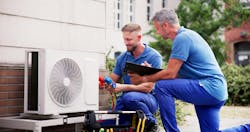Best Practices for Building Up an HVACR Business
During recent conversations with leading HVAC professionals, Emerald Green Mechanical’s General Foreman Jason Norman and industry veteran and content creator Zac DesJardins shared the following tips on how to build and grow a successful HAVCR business.
As the demand for skilled HVACR professionals grows, businesses must be able to adapt to effectively service their expanding customer bases. Before scaling up, it’s important to assess current operations and identify areas for improvement. Strengthening processes, investing in training, and adopting the right tools will lead to long-term success in a competitive industry.
Three clear objectives that contractors and business owners should be focusing on are education, engagement, and continuously building connections. Leveraging these three insights will allow contractors to grab hold of new business opportunities and grow.
Opportunities for Continued Education & Training
The HVACR industry is constantly evolving, requiring business owners to stay current on regulations, technological advancements, and best practices for safe, efficient work. Providing ample opportunities for ongoing education helps technicians remain skilled and adaptable.
Norman, an 18-year industry veteran, leverages manufacturer partnerships to provide hands-on training, sending his team to opportunities such as live-fire labs to become familiar with the latest equipment. He also hosts quarterly gatherings to share best practices and ensure technicians are informed of relevant industry changes. Keeping information flowing between management and the technicians ensures that the entire team is on the same page regarding best practices and expected outcomes.
Overall, training requirements often emphasize the importance of staying in compliance with industry innovations. Staying aligned with industry standards allows businesses to adapt seamlessly to new regulations, such as A2L certification. For example, Emerald Green Mechanical’s prior use of press-fittings and jaws tool allowed them to transition smoothly without workflow disruption, as a flameless solution is often more desirable with the new A2L products.
Emphasis on Culture, Keeping Technicians Engaged
According to a report released in 2024 by the Federal Bureau of Labor Statistics, there are more than 42,500 job openings in the HVAC industry each year. To combat rising turnover rates and the incurred cost of training new technicians frequently, keeping skilled workers engaged and reminded of their value is essential. Though there are many ways to build a strong culture within one’s business, Norman has seen success in physically gathering his team together.
Norman prioritizes team cohesion through outings like fishing trips, golf, and company events, reinforcing camaraderie and morale. As he notes, “We make the effort to show our staff how important they are to the entire operation, every technician has valuable insights that benefit the team as a whole, and we want to ensure they are shared.” Creating a supportive environment ensures technicians can rely on each other and office staff to complete jobs effectively.
In 2019, there was a change in leadership for Emerald Green Mechanical. With the developing trend of private equity firms looking to purchase HVACR businesses, it’s one of the fastest-growing industries globally, with a predicted market value of $338.62 billion by 2031. Investors are eager to get involved in the HVACR industry. Norman approached the new ownership with cautious optimism. The subsequent business growth has provided employees with enhanced opportunities, access to new tools, vehicles, and training programs that were previously unavailable in a smaller company.
Norman was also concerned about maintaining the team's synergy amid the leadership change and the influx of new technicians. However, his commitment to fostering a strong sense of community at Emerald Green Mechanical proved invaluable. Despite more than doubling in size over the past five years, the company has maintained its dedication to both clients and technicians.
Building Connections in the Industry and With Customers
Strong industry and customer relationships are essential for long-term success. Trade shows and networking events provide important opportunities to connect with peers, share insights, and stay ahead of industry trends. For example, the AHR Expo gathers nearly 50,000 professionals over three days, fostering collaboration and innovation within the HVACR industry.
Effective customer communication is just as important. Businesses should adapt messaging to client preferences, whether via email, phone, or text, to enhance engagement and trust. Social media serves as a powerful tool for both industry networking and customer outreach, allowing technicians to exchange knowledge and businesses to maintain an active presence with their audience.
DesJardins, HVACR content creator and longtime industry pro, emphasizes the importance of community involvement, noting that businesses thrive when they stay plugged into the needs of the people they serve. This business tactic is especially relevant when looking to reach the younger generation of clients, as it is something they have come to expect. Proactively engaging with the community strengthens brand reputation and fosters lasting customer relationships. Technicians and staff can be highly trained, but if one is not operating in lockstep with the client base, then efforts may go unnoticed.
There are many moving parts that make up a smoothly run contracting business, but to thrive and expand, sticking to the basics of education, engagement, and connection are key elements that will serve any business well. Manufacturers and other partners can assist in providing resources for continuing education of HVACR technicians. Great business owners leverage every opportunity to foster an environment that encourages their staff and, in turn, their customers to grow.
About the Author

Jessica Slaughter
Jessica Slaughter is the marketing manager at Rapid Locking System (RLS). Jessica has extensive experience in the HVACR industry, and regularly connects with industry insiders, staying on top of the latest trends and best practices to ensure strong brand recognition for RLS within the HVACR industry. Her deep understanding of the HVACR landscape has been essential to RLS’s continued success.
